A self-study, self-paced course where you can learn how to paint in watercolor by watching video lessons and doing assignments
$297 USD
ENROLL NOWA self-study, self-paced course where you can learn how to paint in watercolor by watching video lessons and doing assignments
$297 USD
ENROLL NOWOne-to-one, unlimited and custom-tailored to your skills and needs Personal Tutoring by the Watercolor Academy teachers
$997 USD
ENROLL NOWBy Ilya Ibryaev
It is late afternoon, and the boats are in the marina. In this video lesson, you will learn how to paint boats and their reflection in the water, as well as the cloudy sky and the character of the light. Here is the artwork that was done in the video lesson. It covers an impression of this marina with the sky, boats and water. I will paint on location in watercolor, and this artwork begins with a rough sketch in graphite pencil, directly onto the watercolor paper.
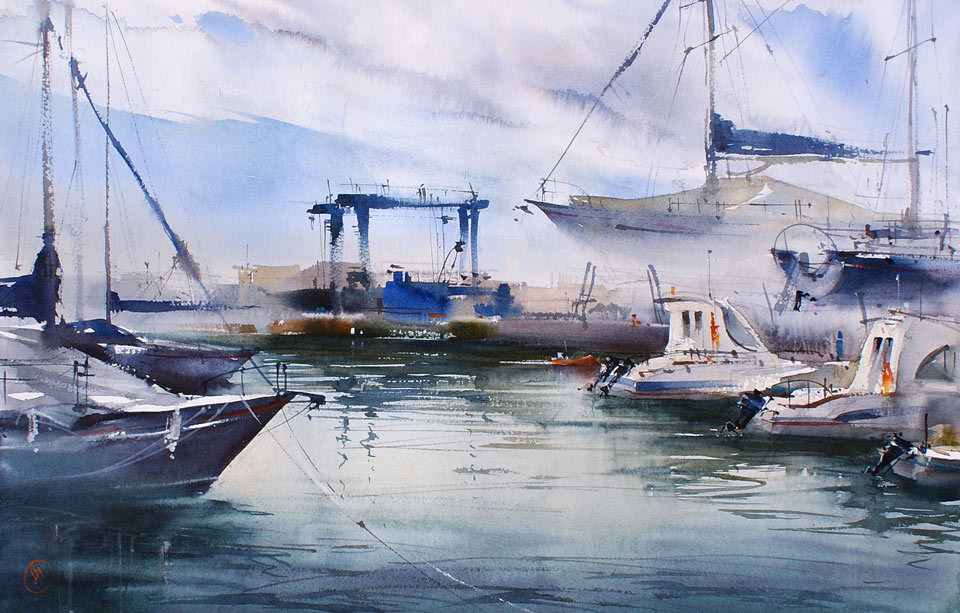
The Sun is in front of me, and I will be painting against the light. To begin, I will use a mixture of Ultramarine and cobalt turquoise light pigments to paint the blue color of the sky. This mix is applied wet-on-dry, with wide brush strokes, using a round mop brush. I add clear water to make a gradated wash, which is darker at the top, and is tinted toward the horizon. The top hard edge can be softened with water as well. The hue of the sky is colder at the top, and warmer closer to the horizon. That is why I add ochre yellow light to continue this variegated wash. The border between cold and warm colors is diffused softly. The Sun is setting, and gives warm colors to the clouds, so I add a very light tint of Cadmium orange here. Then, I rotate the board and paint some of the clouds with diagonal brushstrokes, using the mix of Ultramarine and Cadmium orange. This mix is quite light – this is the first wash for the clouds.
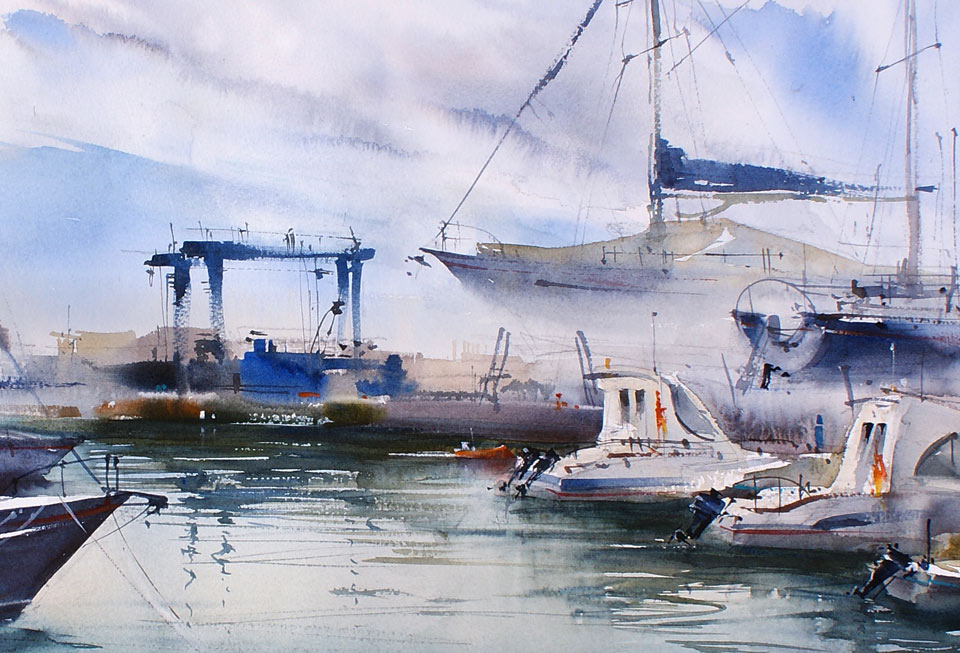
I am now preparing a darker mix of Ultramarine and Cadmium orange, which I will use for painting the clouds wet-into-wet. I rotate the board at different angles, for the wet paint to flow in various directions. The key here is to have just enough water on the brush, and not to overload the paper with paint. You can see that I am using a small flat synthetic brush, which holds less water and is easier to control the wetness with. We can now move on and paint the sea – for its color, I use a mix of Ultramarine with Veridian, and Cobalt turquoise. To warm up this color, I can also add yellow ochre light, and make a variegated wash with a round mop brush. According to the rules of aerial perspective, the closer the objects are to a viewer, the warmer the colors they may have. To create an illusion of this perspective, I also add Cadmium red and yellow ochre light into this wash. This warm color wash serves as the underpainting for the sea water. After this, I can add colder paints wet-into-wet, while keeping the wetness under control, by loading the brush with less water. Also, with a semi-dry brush, I can take off some of the excess water that is on the paper.
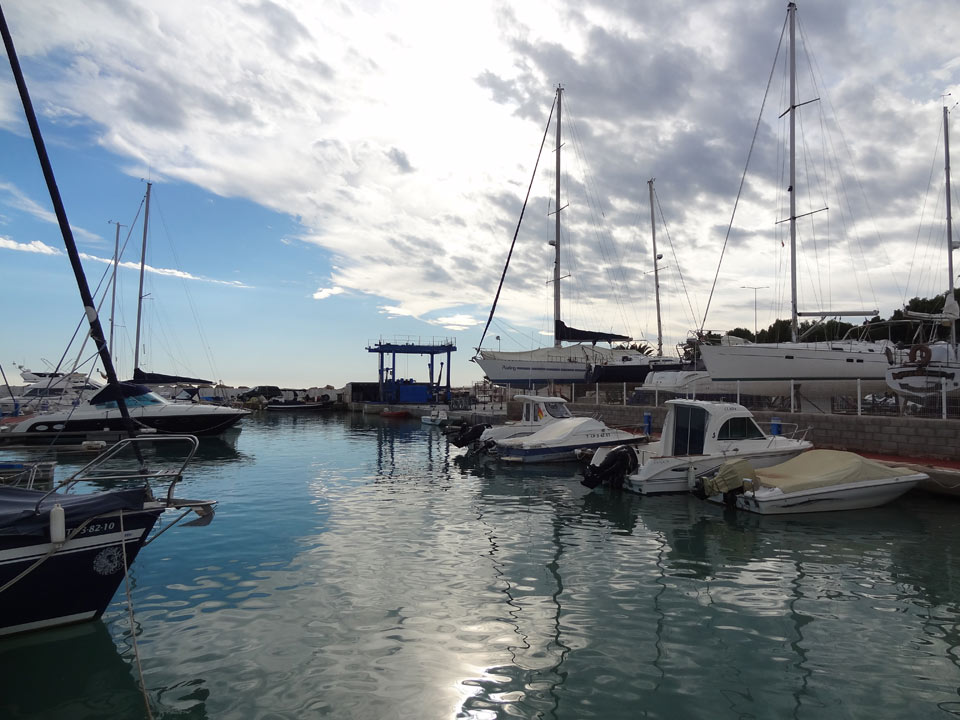
To visually bring the foreground to a viewer closer, I have to make it more saturated. That is why I add a brighter mix of Cadmium orange and Veridian, as well as a mix of Ultramarine with Veridian, to deepen up values and increase saturation. A bit of Cadmium orange and yellow ochre light is also added here. The mix is applied wet-into-wet, and pigments flow across the paper. As the pigments sink in to paper fibres, the tonal values become lighter. Therefore, I keep adding the mix of Ultramarine and Cadmium orange, in order to achieve darker values. For now, I am mainly interested in two things: the contrast of hues, and the light-dark contrast. With a few dark brushstrokes, I suggest the existence of waves on the water. Both bigger and smaller round brushes are used to paint these waves. These brushstrokes are painted wet-into-wet, and diffuse nicely.
It's time to paint some yachts and boats. I make the first wash using the mix of Cadmium orange with a bit of Ultramarine. This mix is applied with a flat wide brush, which is capable of making wide brushstrokes and thin lines. There is very little water on the brush, so I can paint using the dry-brush technique, leaving some accidental white spots within the brushstrokes. I want to make an impressionistic artwork, not a photorealistic painting. That is why I do not describe details, but rather suggest them. Also, the background wall of the marina is not the focal point of this artwork. I keep it very laconic, without many details.
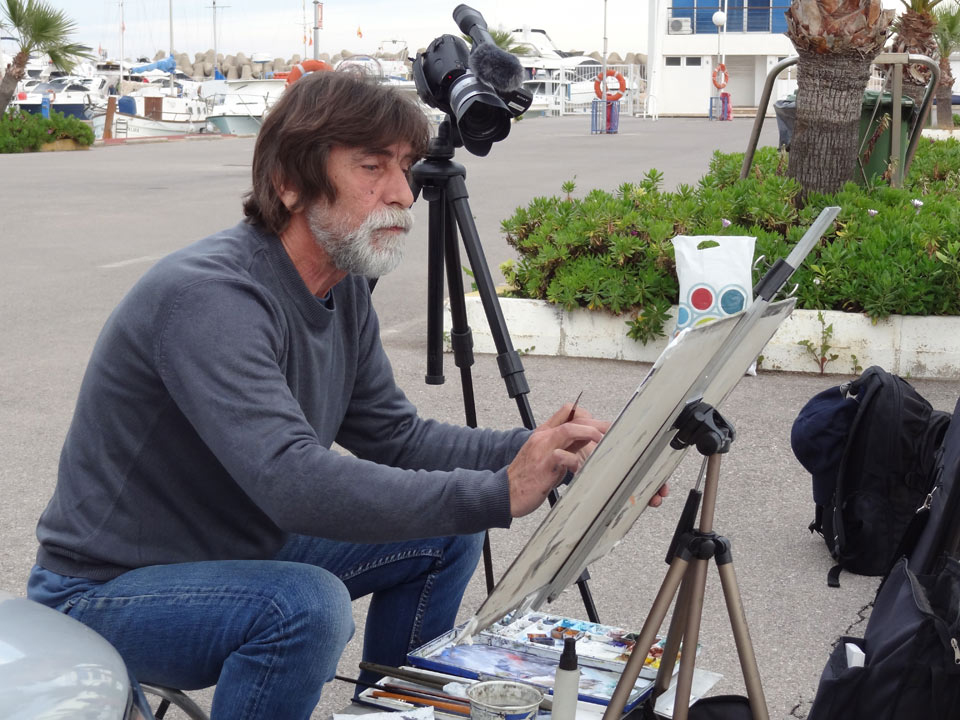
The boats are in the middle ground. Because they are closer to us, they appear with a darker contrast between light and shadows. Before I paint these boats in full color, I would like to complete the background. I am painting this with a flat synthetic brush, which I load with very little water, because the underpainting is not fully dry yet. In the center of this artwork, there is some marina equipment used to lift up yachts from the sea. This big crane is painted in blue, and I might give some attention to it, to tell a story about facilities in this marina. You can see that the crane parts are suggested with a dry brush, and for the smaller details, I use a rigger brush, which is great for making thin lines. I paint the decoration of boats in Ultramarine, and also use the dark mix of Ultramarine with Cadmium orange to mark the doors, windows and other details. I am loading less water on the brush, but more pigment, to paint the details in full strength, in one attempt. For the warmer colors, I am using the mix of Cadmium yellow with yellow ochre light. I will now mix Veridian with Cadmium orange, and also add a bit of Ultramarine, to depict the dark reflection on the water. Such reflection can also contain Cadmium orange and yellow ochre, which both give warmer shades to this mix. I am painting the dark reflection on the water surface with a round medium-sized brush, with a longer belly, which holds more water, and can therefore give paint for a longer time before having to reload the brush. I apply free-flowing brushstrokes, to make an impression of random waves on the water. While the paint is still wet, I can wipe it out in some places, with a natural sea sponge, to soften up the reflection and create a special effect.
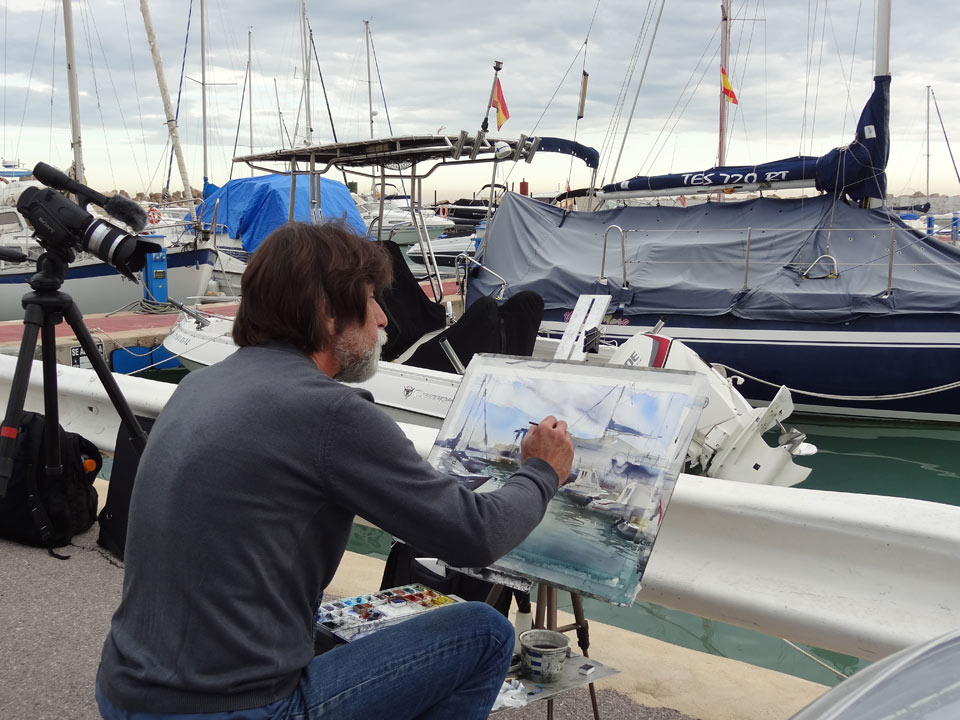
There is one yacht on the right-hand side, which is being taken out from the water and stands on the shore. Its warm color is mixed from Cadmium orange and yellow ochre, and I am also adding a bit of Ultramarine here. A dark mix of Ultramarine and Cadmium orange is used for the side of this yacht, which is in shadow. I want to create an impression, as if this yacht levitates above the ground, and so I make its bottom outline very soft. There is another smaller boat out of the water next to this yacht. I use the rigger brush to paint thin and long lines. There are also boats on the left-hand side; for their dark cold color, I use Ultramarine and Cadmium orange. These two complementary colors produce a nice-looking gray, which would not be obtainable via other methods, such as by diluting a black pigment. I am loading the brush with very little water, but with enough pigment to achieve dark brushstrokes. It is almost a dry brush technique, and the brush leaves unpainted spots. For the dark reflection of this boat, I am using a mix of Ultramarine, Cadmium orange with additional Cobalt turquoise light effect. I also deepen up the shadow side of the boat. Using a semi-dry clean brush, I can wipe out the light stripes before the paint dries.
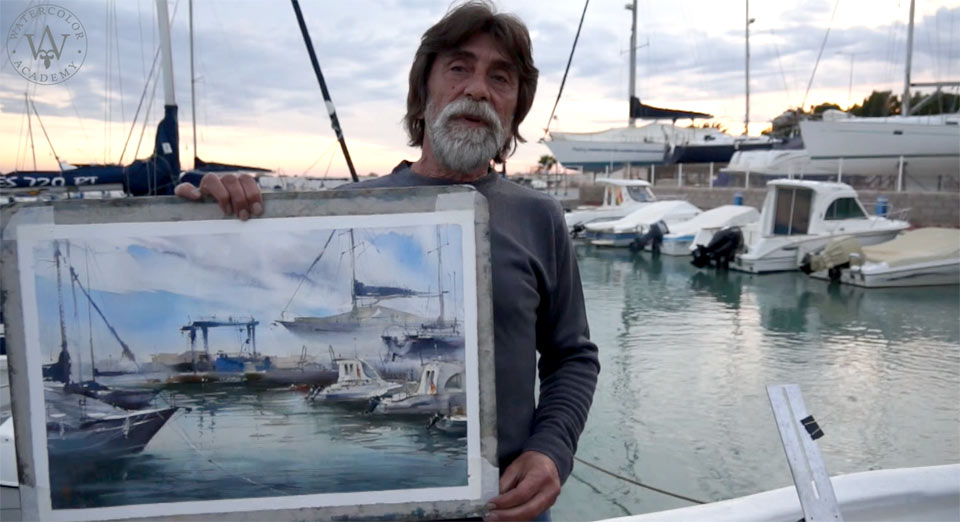
This watercolor artwork is almost complete. I can finish it by adding some small details. A small round brush can be used for this purpose. It depends on your creative task as to how many details you would like to paint. I don't want to overload this artwork with too many features. The task I have in mind is to make an impressionistic snapshot of this place; not a well-documented description of every small detail we can see in this marina. I paint the details in a very rough manner, leaving some white spots untouched to achieve some texture, and to give an impressionistic feeling. I depict the yachts' masts with swift dry brush lines. You can see that these lines are almost broken and have unpainted gaps. Such a dry brush technique works very well in combination with soft and diffused washes. Accuracy and precision of lines are not required for an impressionistic artwork. I am making some finishing touches, with very opaque marks of Cadmium orange, and I also add a tiny bit of Chinese white to make some highlights. I take pure undiluted paint directly from the tube; it is important though not overdo the white pigment when adding it. Instead, such details have to be applied very sparingly...
A self-study, self-paced course where you can learn how to paint in watercolor by watching video lessons and doing assignments
One-time payment - Lifetime membership
$297 USD
One-to-one, unlimited and custom-tailored to your skills and needs Personal Tutoring by the Watercolor Academy teachers
One-time payment - Lifetime membership
$997 USD